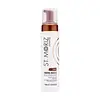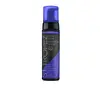St. Moriz Advanced Colour Correcting Tanning Mousse Versus St. Tropez Self Tan Suprême Violet Mousse
What's inside
What's inside
 Key Ingredients
Key Ingredients

 Benefits
Benefits

 Concerns
Concerns

 Ingredients Side-by-side
Ingredients Side-by-side

Water
Skin ConditioningDihydroxyacetone
Skin ConditioningCaprylyl/Capryl Glucoside
CleansingPropylene Glycol
HumectantDimethyl Isosorbide
SolventPhenoxyethanol
PreservativePolysorbate 20
EmulsifyingParfum
MaskingSodium Metabisulfite
AntioxidantEthylhexylglycerin
Skin ConditioningPanthenol
Skin ConditioningBiosaccharide Gum-1
HumectantCoumarin
PerfumingSodium Hyaluronate
HumectantCI 16035
Cosmetic ColorantCI 19140
Cosmetic ColorantCI 17200
Cosmetic ColorantCI 42090
Cosmetic ColorantWater
Skin ConditioningDihydroxyacetone
Skin ConditioningCaramel
Cosmetic ColorantPentylene Glycol
Skin ConditioningEthoxydiglycol
HumectantGlycerin
HumectantPPG-5-Ceteth-20
EmulsifyingErythrulose
TanningCoco-Glucoside
CleansingDimethyl Isosorbide
SolventPropanediol
SolventPhenoxyethanol
PreservativeParfum
MaskingMelanin
Skin ProtectingHydrolyzed Jojoba Esters
Skin ConditioningSodium Metabisulfite
AntioxidantHydroxyethylcellulose
Emulsion StabilisingTocopherol
AntioxidantBenzyl Salicylate
PerfumingCitric Acid
BufferingCaprylyl Glycol
EmollientDecylene Glycol
Skin ConditioningPorphyridium Cruentum Extract
Skin ConditioningLeuconostoc/Radish Root Ferment Filtrate
AntimicrobialGeraniol
PerfumingCoumarin
PerfumingLimonene
PerfumingAlpha-Isomethyl Ionone
PerfumingCI 16035
Cosmetic ColorantCI 19140
Cosmetic ColorantCI 42090
Cosmetic ColorantCI 17200
Cosmetic ColorantWater, Dihydroxyacetone, Caramel, Pentylene Glycol, Ethoxydiglycol, Glycerin, PPG-5-Ceteth-20, Erythrulose, Coco-Glucoside, Dimethyl Isosorbide, Propanediol, Phenoxyethanol, Parfum, Melanin, Hydrolyzed Jojoba Esters, Sodium Metabisulfite, Hydroxyethylcellulose, Tocopherol, Benzyl Salicylate, Citric Acid, Caprylyl Glycol, Decylene Glycol, Porphyridium Cruentum Extract, Leuconostoc/Radish Root Ferment Filtrate, Geraniol, Coumarin, Limonene, Alpha-Isomethyl Ionone, CI 16035, CI 19140, CI 42090, CI 17200
Ingredients Explained
These ingredients are found in both products.
Ingredients higher up in an ingredient list are typically present in a larger amount.
Ci 16035 is a synthetic dark-red dye. This dye is created from an acid called Allura red AC, an azo dye.
Azo dyes need to be purified thoroughly before use. This makes them more stable and longer lasting.
This dye is commonly used in foods, approved by both the FDA and EFSA.
Learn more about CI 16035Ci 17200 is a synthetic reddish-purple dye.
CI 19140 is also known as Tartrazine. Tartrazine is a synthetic dye used in cosmetics, foods, and medicine to add a yellow color.
Tartrazine is created from petroleum and is water-soluble.
Some people may experience allergies from this dye, especially asthmatics and those with an aspirin intolerance.
Learn more about CI 19140Ci 42090 is a synthetic dye created from petroleum. It is used to give a bright blue color to cosmetics, medicine, and food.
Coumarins are a group of substances found naturally in plants. There are over 1300 types of coumarins identified. It has a natural vanilla scent.
Coumarin is an identified EU known allergy, meaning it may cause an allergic reaction when applied to the skin.
In many countries, coumarin is banned as a food additive. However, it can be found in soaps, tobacco products, and some alcohol drinks.
Plants use coumarins as a chemical defense. Some plants that have coumarins include lavender, tonka beans, and yellow clovers.
Learn more about CoumarinDihydroxyacetone, or DHA, is a simple sugar. It is frequently used in self-tanning products.
DHA binds to the amino acids in your dead skin cells to create a brown/orange color. Darkening begins to kick in a few hours after application and will continue to develop for up to 3 days. This ingredient can be drying.
Both the US and the EU have approved DHA in self-tanning products. In the EU, DHA is allowed at a maximum concentration of 10%. Most tanning products usually contain amounts between 3-5%.
If you are pregnant or have underlying medical conditions, it is best to speak with a dermatologist about using self-tanning products.
Learn more about DihydroxyacetoneDimethyl Isosorbide is a low-irritation solvent that helps deliver actives into your skin. It is created from glucose.
Research shows how well this ingredient works depends on the active and formulation rather than the concentration alone. This means adding more Dimethyl Isosorbide does not guarantee better penetration of ingredients into the skin.
Parfum is a catch-all term for an ingredient or more that is used to give a scent to products.
Also called "fragrance", this ingredient can be a blend of hundreds of chemicals or plant oils. This means every product with "fragrance" or "parfum" in the ingredients list is a different mixture.
For instance, Habanolide is a proprietary trade name for a specific aroma chemical. When used as a fragrance ingredient in cosmetics, most aroma chemicals fall under the broad labeling category of “FRAGRANCE” or “PARFUM” according to EU and US regulations.
The term 'parfum' or 'fragrance' is not regulated in many countries. In many cases, it is up to the brand to define this term.
For instance, many brands choose to label themselves as "fragrance-free" because they are not using synthetic fragrances. However, their products may still contain ingredients such as essential oils that are considered a fragrance by INCI standards.
One example is Calendula flower extract. Calendula is an essential oil that still imparts a scent or 'fragrance'.
Depending on the blend, the ingredients in the mixture can cause allergies and sensitivities on the skin. Some ingredients that are known EU allergens include linalool and citronellol.
Parfum can also be used to mask or cover an unpleasant scent.
The bottom line is: not all fragrances/parfum/ingredients are created equally. If you are worried about fragrances, we recommend taking a closer look at an ingredient. And of course, we always recommend speaking with a professional.
Learn more about ParfumPhenoxyethanol is a preservative that has germicide, antimicrobial, and aromatic properties. Studies show that phenoxyethanol can prevent microbial growth. By itself, it has a scent that is similar to that of a rose.
It's often used in formulations along with Caprylyl Glycol to preserve the shelf life of products.
Sodium metabisulfite is also known as Sodium Pyrosulfite. It is a preservative, antioxidant, and disinfectant.
As a preservative, it helps stabilize cosmetic formulas without affecting their color or scent.
Water. It's the most common cosmetic ingredient of all. You'll usually see it at the top of ingredient lists, meaning that it makes up the largest part of the product.
So why is it so popular? Water most often acts as a solvent - this means that it helps dissolve other ingredients into the formulation.
You'll also recognize water as that liquid we all need to stay alive. If you see this, drink a glass of water. Stay hydrated!
Learn more about Water